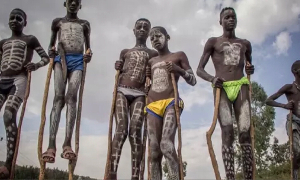WONDERS!! The Extraordinary Tribe In Ethiopia Where Young Men Walk On Stilts To Protect Themselves From Wild Animals

The diverse cultures of the world are intriguing and fascinating. Every tribe has a fascinating culture and background. Let's take a quick look at the history of the Ethiopian Banna tribe, where young males walk on slits.

In order to walk while elevated above a regular height, walking stilts are described as "poles equipped with stairs for the feet to stand on and straps to attach them to the legs."
Stilt walking has been used for a very long time, whether it be for domestic or agricultural purposes, masquerades, or to make it easier to get through marshy terrain, as certain French villages did in the late 1800s.
The old art is currently mostly employed for entertainment during festivals, parades, and public activities.
Tribe of Banna
The dry regions east of the Omo River are home to the Banna people of Ethiopia.
According to legend, the reason the men moved around their region on stilts was to avoid being attacked by wild animals. However, if you were to move to the Lower Omo Region, where the Banna often live, you would see that wearing stilts has mostly turned into a pastime enjoyed mostly by young boys, making them noticeably taller than others.
Visitors seeking to experience the distinct culture and traditions that have persisted for hundreds or thousands of years can now find Banna settlements as a popular tourist destination.
The Banna, sometimes known as the Benna or Banya, elevated tradition. They are a Nilotic ethnic group with roughly 45,000 members in Ethiopia, with some concentrated around Chari Mountain near Kako Town and a savanna region close to Dimeka, according to a report by the Atlas of Humanity. The report further stated that the Banna have their own king and are predominately Muslims.
As they live close to the Hamer people, who inhabit the hills covered in vegetation on the eastern side of the Omo Valley in southern Ethiopia, some historians refer to them as the Hamer-Banna.
It is known that the Banna descended from them hundreds of years ago, but they later moved in search of pastures to breed their cattle. Even though the Banna are recognized for their beekeeping, the majority of them are still involved in cattle breeding. In the dry season, men travel great distances with their herds in search of water, grass, and wild honey.
However, having close ties to their Hamer neighbors means they follow similar customs and rituals. The Banna boys, who live in camps made up of numerous connected families, must undergo a number of ceremonies, including a ceremony that involves jumping over a herd of cattle, to demonstrate that they are of legal age.
The Banna typically require young men to participate in the cow-jumping or bull-leaping rite, just like the Hamer, before they are eligible for marriage, can possess cattle, and can have children.
The ceremony is concluded with a celebration once the young man successfully jumps over 15 cows to be permitted to marry. Women support them in every way possible by singing and dancing.
Additionally, Banna males can marry multiple women, just like the Hamer, and the bride price is frequently cattle and other valuables. Additionally, a male may be called to defend a widow, a divorcee, or the spouse of an absent husband, typically his brother.
It's interesting to note that the magnificent hairstyles worn by Banna women, which had butter-held beads, are nearly identical to those worn by Hamer women. To maintain hair wonderfully supple and sun-protected, butter is applied to it.
